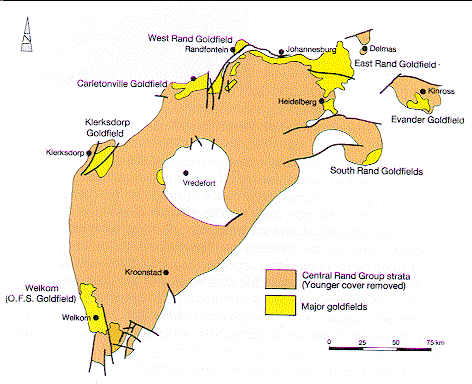| |
1 |
Witwatersrand Basin (RSA) |
|
The history:
By far the most gold that has been mined in South Africa (98%) has come come from the Witwatersrand goldfields. The name "Witwatersrand" is Afrikaans (originating out of Dutch, French and German) for "White Waters Ridge". The name was derived from the white quartzite ridge which strikes parallel to the edge of the basin in which the sediment was deposited. The gold mines in this area are situated around an ancient sea (over 2700 million years old) where rivers deposited their sediments in the form of sand and gravel which became the conglomerate containing the gold. The Witwatersrand Basin is approximatly 350 km long and 200 km wide. The gold mines in this area are possibly the deepest mines in the world (mining operations at 3600 m and exploration core-drilling up to 4600m). Peak gold production occured in 1970 when over 1000 metric tommes were mined, generating US $1,164 billion in sales, however gold production has declined since 1980. The average recovery grade of the Witwatersrand gold mines has declined from 13,28 grammes/tonne in 1970 to 5,3 grammes/tonne in 1991.2

Minerals:
Over 100 mineral species have been reported from the gold-bearing reefs. Most of the minerals are esoteric and visible only under the microscope and seldom form larger collector specimens. Zircon, chromite and other "heavy minerals" occur throughout the Witwatersrand. The most common silicate minerals in the reefs are quartz, muscovite, pyrophyllite, chloritoid and chlorite. The sulphide minerals are the second most abundant minerals superceded only in volume by quartz. A wide variety of nickel-cobalt-platinum sulpharsenides as well as copper sulphosalts ans antimony-bearing minerals are present. Included in this group are speciessuch as cobalt-rich arsenopyrite, gersdorrite and cobaltite, and the platinum group minerals geversite, sperrylite, braggite and cooperite. Pyrite is present in a variety of habits and forms. The main uranium-bearing minerals are uraninite and brannerite with minor amounts of coffinite and uanothorite. Uranium (and gold) tends to be enriched when found in combination with carbon. In some places a "reef", the Carbon Leader, is developed and mined as the gold content is exceptionally high.3
Diamonds are also assiciated with the Wtwatersrand reefs (some diamonds up to 8 carats where found). There failure however was there green colouration ranging from a nuance of green to bottle green and almost black. This colour it was found to be the result of the natural radiation caused with the association of uranium. Diamonds are however no longer recovered from the Witratersrand gold mines due to a change in the reduction procedure. Most of the gold in the Witwatersrand is present as native gold which occures in a variety of formes and habits, such as microscopic veinlets or overgowths and is usually only visible under the microscope (the average gold particle ranges from 0.005mm to 0.5mm in diameter). There are however remarkable exceptions. On the Randfontein Estates gold mine, gold was found in an area where a dolerite dyke had transgressed the strata and the gold was found "smeared into" the fault planes. Spectacular finds of native gold were also found in the City Deep Mine. One of these finds comprised of a interwoven gold crystals which formed small mats found between the walls of a fissure (associated with a dolerite sill) in the Main Reef Leader. Close to the fissure 15-20cm rhombohedral calcite crytals where found. In this mine beautiful clear quartz crystals up to 10cm long with small calcite crystals were found.4
Quartz in particular is periodically found as well-formed and often very aesthetic specimens. The strata in the gold mines have been subject to tremendous pressures and deformation resulting in the fracturing of the rocks along fault zones. Forthermore the Witwatersrand strata was introduced by younger igneous rocks which are often associated with the faults. These two features result in favourable conditions for the percolation and migration of fluids with often large quantities of dissolved silica in them. It is in these fluids that the quartz crystalised. The shapes of quartz vary from long needle-like crystals such as from the Vaal Reefs Mine to the water-clear forms, sometimes showing phantom growhts within from the Hartebeesfontein Mine. Some of the quartz is associated with secondary minerals such as iron hydroxide, goethite, and these stain the quartz an orange colour.5
Pyrophyllite in also common in the Witwatersrand rocks. Occasionally, this golden-coloured mica can be seen as minute flakes on quartz specimens. Pyrite is also very common in the gold-bearing reefs either as small grains or as round blobs resembling buck-shot. The pyrite also sometimes crystalises as octahedral, cubic shapes or displays other composite forms when in conjunction with quartz. The pyrite can also crystalise as minute 1mm crystals and then form a dusting covering of gold-coloured pyrite on larger minerals. This occures in mines such as South Roodepoort Mine, Presedent Steyn Mine and West Driefontein Mine. At Kloof Mine this occures as well, here one also findes water-clear quartz with pink dolomite crystals.6
7
Buying/collecting:
The minerals from the Witwatersrand gold-reefs can usually only be got from miners or geologists (or from dealers/ collectors who buy from miners or geologists). It should be noted that mineral collecting by the miners it is usually seen as a criminal offence.
Footnotes
"Minerals of South Africa" by Bruce Cairncross and Roger Dixon:
1: Cairncross, B./Dixon, R.: in Minerals of South Africa, Singapore 1995, p. 31-35.
2: Cairncross, B./Dixon, R.: in Minerals of South Africa, Singapore 1995, p. 37f.
3: Cairncross, B./Dixon, R.: in Minerals of South Africa, Singapore 1995, p. 39ff.
4: Cairncross, B./Dixon, R.: in Minerals of South Africa, Singapore 1995, p. 41.
5: Cairncross, B./Dixon, R.: in Minerals of South Africa, Singapore 1995, p. 41ff.
6: Cairncross, B./Dixon, R.: in Minerals of South Africa, Singapore 1995, p. 38.
7: Cairncross, B./Dixon, R.: in Minerals of South Africa, Singapore 1995, p. 38.
Back to Home
